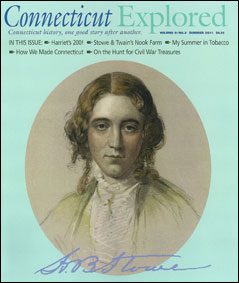(c) Connecticut Explored Inc. Summer 2011
Subscribe/Buy the Issue!
I signed up to take part in the 24-hour read-a-thon of Uncle Tom’s Cabin at the Harriet Beecher Stowe House on June14. Starting at 10a.m., in honor of the 200th anniversary of Harriet Beecher Stowe’s birth, we volunteers will begin reading aloud the book that made Stowe internationally famous. We’ll take turns in 10-minute shifts until the last word is read, approximately 20 hours later.
I signed up because Uncle Tom’s Cabin is one of my favorite books, and I want to be a part of honoring Stowe, a Connecticut daughter whose convictions and actions helped propel this nation toward the abolition of slavery.
And yet … it always feels as though you’d best explain yourself in admitting you like this book. In his column on page 13, State Historian Walt Woodward explains why he only recently over came his prejudices and brought himself to read it. Despite the huge success of Uncle Tom’s Cabin in the mid-19th century, it was thoroughly denounced in the 20th century before making a slow comeback fueled, in part, by the work of feminist scholars such as Ann Douglas and Jane Tompkins*. To be sure, the book must be taken in context, accounting for the time in which it was written, who Stowe was, and for whom she was writing. As a2 1st-century reader, you have to tolerate a certain amount of melodrama, strident Protestant theology, and painful attitudes about race—not your usual book-club fare these days. Get past all that, though, and you’ll be rewarded, as Woodward reports he was, and perhaps you’ll be moved to join me, either as reader or audience member, on June14. (*For an interesting discussion about this topic, see Stephen Metcalf’s May 2005 column “UncleTom’s Children” on Slate.com.)
In celebration of Stowe’s 200th birthday, this issue honors the author and her legacy. We thank the Harriet Beecher Stowe Center for collaborating with us in putting it together. The fame Stowe found abroad while promoting her book and trying to secure international copyrights is the subject of Stowe Center Director Katherine Kane’s feature story. Historian Barbara Sicherman mined the Connecticut Women’s Hall of Fame for a photo essay that reminds us that Stowe is neither the first nor the last Connectican to effectively fight for a more just world. Ben Gammell took up the theme in writing about the Connecticut Historical Society’s new exhibition “Making History,” which explores life in Connecticut from 1550 to the present and the people who have made our state what it is today.
It’s summer, and that means it’s time to get out and about to visit historic sites and museums throughout the state. You’ll want to read historian Bill Hosley’s top picks of places to see treasure troves of Civil War material. Many organizations are putting on Civil War-related exhibitions and events (see the Events tab on www.ctexplored.org for a list), and you’ll find Stowe 200th events on page 43 and on our Website. The Explore! boxes that accompany some articles, Spotlight, and Afterword are also great places to find ideas for a summer day trip.
In your travels around the state this summer, be inspired by the many Connecticans who have worked in myriad ways (and still do) to make our state—and our nation—a better place to live.
Explore!
Read all of the stories in the Summer 2011 issue, including State Historian Walt Woodward’s column
Read all of our stories about the Civil War on our TOPICS page
Use the search to find for all of our stories about Harriet Beecher Stowe

